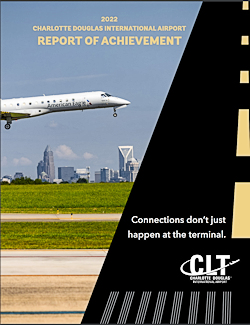Imitation is the Sincerest Form of Flattery...or Deception
In preparing this issue, I needed information about Harry Reid International, so I typed the airport name into my browser. The first URL on the list was vegasmeansbusiness.com. The second was las-vegas-airport.org. Also appearing on the list were las-vegas-airport.com and harryreidairport.com.
 Which is the real/official airport website? In this case, there were two, not one. Vegasmeansbusiness.com and harryreidairport.com are the real McCoy, I mean McCarran, no Reid. But all four websites displayed photos and information about the airport. To the untrained eye, the two imposters can look legit, even though the sites do confess (in smaller fonts) that they are not official.
Which is the real/official airport website? In this case, there were two, not one. Vegasmeansbusiness.com and harryreidairport.com are the real McCoy, I mean McCarran, no Reid. But all four websites displayed photos and information about the airport. To the untrained eye, the two imposters can look legit, even though the sites do confess (in smaller fonts) that they are not official.
This online sleight of hand is not unique to LAS. It is something many commercial airports are dealing with. Airports that need to inform their own passengers and public have to compete with entrepreneurs with websites designed purely to cash in on very visible public assets. Naturally, the more traffic you bring to your website, the more valuable it is.
Websites are now in the same category as Rolex watches and Gucci handbags: buyer/user beware.
Are we destined to wave the white flag and put up with this? Not at all! Make it clear in every conceivable way which is the real airport website. The best defense is to provide more and better information than the wannabes.
One of the first places I would start is looking closely at the content provided by your competitors. Make sure that any features and benefits are better on your website than theirs. Also, check how easy it is to connect with the leaders/departments at your airport. Many of you do an excellent job providing contact information. But there is still a large contingent of airport websites without any clues about who is running the various departments and how to get ahold of them.
Competition can be a real pain in the butt. However, it also invariably makes us better. Let’s make our websites better.
Cheers!

-Paul
2022 Charlotte Douglas International Airport Report of Achievement
 Giving back to the community is central to what Charlotte Douglas International Airport and its operator, the City of Charlotte Aviation Department, is about, and last year was no different.
Giving back to the community is central to what Charlotte Douglas International Airport and its operator, the City of Charlotte Aviation Department, is about, and last year was no different.
Throughout 2022, while recovering from the COVID-19 pandemic, we continued our efforts to have a positive impact on the Charlotte community. Of particular note, we spent the year sharing stories of how Connections Don't Just Happen at the Terminal - from creating homeownership and employment opportunities to supporting economic growth through small-business development and offering outreach programs to help residents understand the Airport better.
This whitepaper highlights the construction projects, initiatives, programs and events that validate Charlotte Douglas as a premier airport.
Download the whitepaper: 2022 Charlotte Douglas International Airport Report of Achievement.








